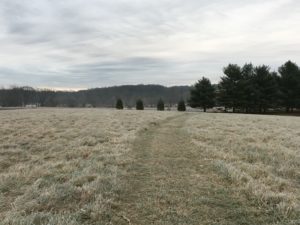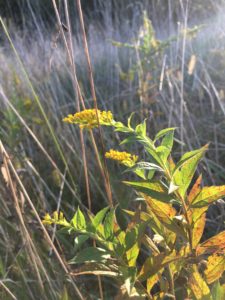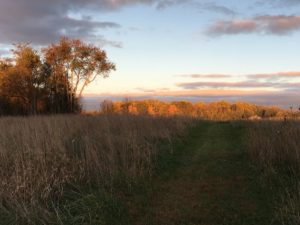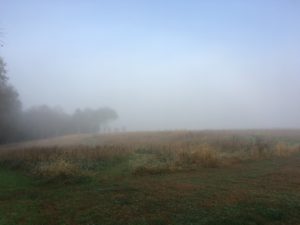The Year: Overall Success
Overall, the quickie meadow was a success; the family and their visitors loved the color, vibrancy, and feel of the meadow. It sheltered wildlife and provided breeding habitat and food sources for many pollinators including Monarchs, native bees and honeybees. The paths that wind through the grass make it a place to wander and enjoy – they make the meadow a garden. It is a place that delights the senses.
enjoy – they make the meadow a garden. It is a place that delights the senses.
There were surprises. One goal was to identify the plants and flowers that were resident in the seed bank; species missing could be introduced via seed and plugs. I was surprised by the lack of flower seeds in the field. I had expected to at least see Goldenrod, Aster and Joe Pye Weed amongst the Milkweed and Queen Anne’s Lace. The flowers of the three Goldenrod in my plant census were eaten by the deer so no seeds were available for the next season. The one Aster  bloomed like crazy and dropped lots of seeds, self-sowing its own plant community. Sadly, no Joe Pye Weed appeared in the field. Happily, a significant amount of Milkweed bloomed and sent seeds wafting across the field and beyond.
bloomed like crazy and dropped lots of seeds, self-sowing its own plant community. Sadly, no Joe Pye Weed appeared in the field. Happily, a significant amount of Milkweed bloomed and sent seeds wafting across the field and beyond.
I was surprised by the variety of grasses in the field: tall, short, bunching, elegant, warm season, cool season, blooming red, pink, green. The diversity delighted the eye and attracted many different insects, arachnids and birds.
I was also surprised by the fertility of the soil in the construction field. The seeds literally burst out of the ground with a colorful and vibrant display. The seed mix included annuals for a big show in Year 1 and biennials that will hopefully populate the meadow for many years.
The family was so happy that they would like to repeat it for next year. They also loved the budget and would like to repeat that, too! The long-range plan had called for plugs to be installed in plant communities concentrated for color near the house and gradually transitioning to mostly grass punctuated with color as it moved up and away from the house. With a limited budget, that plan needed rethinking. What we have developed is a plan that relies on seeds for Year 2 color and long-term establishment of perennials.
gradually transitioning to mostly grass punctuated with color as it moved up and away from the house. With a limited budget, that plan needed rethinking. What we have developed is a plan that relies on seeds for Year 2 color and long-term establishment of perennials.
 When I stop and think about it, planting out the field with plugs would provide instant gratification but planting the field with seeds is a much more nature based approach. In that approach in our mid-Atlantic environ, birds, animals, and the wind would deliver flower, tree and shrub seeds to the field. Left untended, the meadow would eventually transition to forest: first there would be meadow flowers, then some woody plants, then some cedars and eventually trees would populate the field. At this meadow, we will work with nature, adding to the seed bank and slowly add to the seed bank native flowers and grasses that would naturally occur. We will interrupt the cycle, though, and tend the meadow as a diverse, ever-changing garden that delights the senses and invites one in to meander, engage and enjoy.
When I stop and think about it, planting out the field with plugs would provide instant gratification but planting the field with seeds is a much more nature based approach. In that approach in our mid-Atlantic environ, birds, animals, and the wind would deliver flower, tree and shrub seeds to the field. Left untended, the meadow would eventually transition to forest: first there would be meadow flowers, then some woody plants, then some cedars and eventually trees would populate the field. At this meadow, we will work with nature, adding to the seed bank and slowly add to the seed bank native flowers and grasses that would naturally occur. We will interrupt the cycle, though, and tend the meadow as a diverse, ever-changing garden that delights the senses and invites one in to meander, engage and enjoy.
